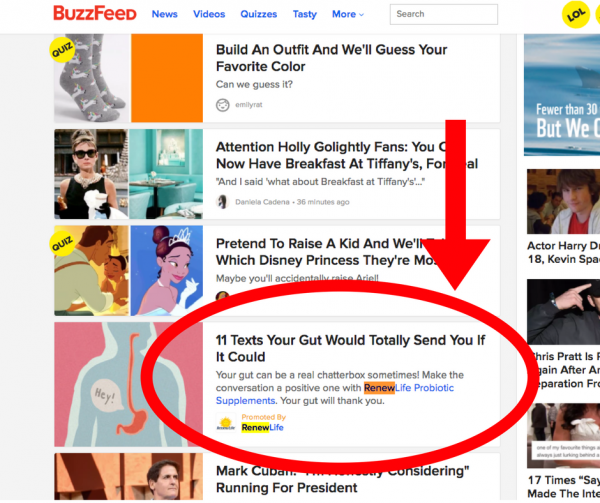Marketing in Camouflage: Native Advertising for Manufacturers
by Emily Swet
Native advertising for manufacturing brands can be a mighty tool in your marketing arsenal. And with native predicted to drive 74% of ad revenue by 2021, it’s worthy of consideration. Let’s take a closer look at the basics of native advertising to see if it’s a good fit for your manufacturing brand.
First, What Is Native Advertising?
Native advertising is an ad format that looks like the editorial content around it. It’s different from content marketing, which is unpaid and lives on your website and social channels. Instead, native ads are paid placements in publications (or their online counterparts) that offer other value to your customers.
Isn’t That Just a Fancy Word for an Advertorial?
Advertorials are similar: longer-form ads written in an editorial style to evoke the same experience as a publication they are placed in. You’ve likely heard of them – they’ve been around since the 1940s (and are the precursor to today’s infomercial). Advertorials are generally much more promotional. They usually focus on the benefits of the product/service being offered and often push to sell.
In contrast, native ads usually focus on highly targeted content from which the reader can gain value. There is less emphasis on the product behind the article, and no sales pitch. Brands gain value in return by positioning themselves as thought leaders in their industry, building trust and brand affinity.
What Are the Benefits?
- They Are Appealing. Consumers view native advertising more often then banner ads.
- They Are Empowering. When done correctly, native ads give prospects the power to find solutions to their problems.
- The Leads Are Good. Because the content is relevant and highly targeted, you get more high-quality leads. This is particularly true if you are putting native ads on the sites of niche trade publications.
What Are the Drawbacks?
- Scalability. Producing native ads can be demanding. Each ad needs to look and sound like part of its environment. That means you risk authenticity or value, especially under a deadline, if you push for quantity.
- It can be perceived as deceptive. People don’t want to be tricked. There’s a delicate balance: your content must flow naturally with the publication. But you also can’t leave your reader feeling betrayed when they notice it’s sponsored. Your content should be relevant and insightful or useful in some way.
- One bad apple spoils the bunch. There are plenty of brands creating native ads that are simply too promotional. This makes some consumers leery of native ads in general. But according to Forbes, standards for native are set to increase, making it necessary for advertisers to follow rules and regulations.
What Does This Mean for Your Brand?
To conclude, native advertising can fall right in your prospect’s wheelhouse – if it’s done right. Offer something useful to your buyer from the outset, and you’ll build loyalty and name recognition. (And pull them into your sales funnel.) But like any kind of advertising, native ads require expertise, testing, and evaluation to monitor your success rates.
Continue ReadingKnow Your Enemies: A Checklist for Manufacturers
by MGB2B
In the early stages of developing a Marketing Plan, it is crucial for manufacturers to understand not only who their target audience is and what they desire, but who else is within the realm of consideration. Sometimes you think you know your competitors well. But you can learn a lot from doing a robust competitive analysis and a little core user research.
START WITH A RE-EVALUATION OF YOUR COMPETITIVE SET
The competition can change from year to year, so it’s very important you don’t gloss over this part. Perhaps one of your competitors switched their main focus from defense to aerospace. That affects you in one way or another, so you’ll need to do a bit of homework. Knowing each competitor’s game plan is essential.
There are many questions you can ask when evaluating your competitors, but these four are required in order to position yourself correctly:
- What’s their primary message?
- How do they position themselves?
- What do they do differently than you do?
- What do you do better than they do?
Evaluate your competitors with as much depth as you would your own brand. Make a list of your major competitors. Go over them one by one, and ask yourself the questions above. Then look at their websites, their social media sites, their ads. Leave no stone unturned. And have a very detail-oriented person on your team create a spreadsheet to house all of this information. This way you can evaluate over time. By the end, you’ll have a thorough assessment of where your brand stands and how you can stand out to prospects.
CONDUCT CORE USER RESEARCH TO GET MORE QUALITATIVE INSIGHTS
Beyond the competitive set, core user research can give you more qualitative insights into how you are regarded in comparison to your competitors. The second part of your checklist is aimed at what you want to find out from your core users. Keep in mind, these are people who like you, so they may be reluctant to tell you what they like about your competitors. That’s why it’s always wise to get a third party involved to gather this research.
You’ll want to ask:
- Who did they consider partnering with before they chose your company?
- Why did they choose to work with you over the others?
- What do they like about the other manufacturers that you didn’t offer?
- What are all the aspects they consider, and in what order, before choosing a manufacturing partner?
- Who in their company makes decisions?
These are just a few questions to get the ball rolling. You can make your research as robust as you’d like as long as you don’t take up too much of your customers’ time.
Once you have both your competitive analysis and core user research done, you’ll know your enemies (er, competitors) better than yourself. And you can start building personas and a Marketing Plan that’s more effective than ever. May the force be with you.
Continue Reading


